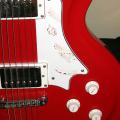The following is a guest post by Kevin Ian Common. If you are interested in guest posting, please contact me!
Hello Kind Readers!
My last column discussed order of pedals in pedal boards. This short and sweet column tackles the on-going debate of “amp-like,” “true-bypass,” and “transparent.”
With the advent of the gear forums, I’ve noticed a very big mob mentality when it comes to gear discussions. Seems like people are more ready to write you off because you don’t subscribe to their idea of perfect tone. I go and I search for “best overdrive” or “best chorus” or “best delay” and I research all of these pedals to find that many of them are god-awfully expensive. You find that one person to mention Boss or Danelectro or even Arion and the pack goes for the kill. How crazy!
I find that enough people come up to me after a show and comment on how they like my tone or wonder how I get a certain sound. It always surprises them when they see my board and find such cheap pedals there. Also, I trust in that no matter what I play, it’s me, and people will be able to point out MY C chord in a sea of millions.
I understand that there are things I may not fully understand about pedals and how they work, but I feel that some of these buzz words are robbing budding and experienced guitarists of their essential journey of discovering tone. The debate and thought-process I hope to ignite revolves more around what sounds best for YOU. Remember, my opinion is only one of millions, but I am fortunate enough to share mine on such a public platform. Read on, you might discover something
Transparent-
After spending some time with what are considered “transparent pedals,” I have decided that the idea of not affecting my tone is not a factor in choosing my pedals. If I step on a pedal, I want it to do something. I bought my overdrive pedal to impart some kind of coloration on my tone. I am looking to alter it in some way, that’s why I buy pedals in the first place.
Of course this doesn’t mean go out and buy a twenty-dollar distortion and call it good. However, if that twenty-dollar pawn shop find works best for you, then why not keep it?
I once bought a certain overdrive pedal because my favorite band made my favorite album of theirs with THAT pedal exclusively. After finding it on eBay and winning it, I thought I had hit the jackpot! Turns out, while it worked with many aspects of my sound, it did not translate well to chords. And even worse, certain chords sounded downright terrible through the effect. As much as it hurt me, I had to let it go. I now have a distortion pedal that not only suits my needs, but allows me enough flexibility to achieve any tone I want for any situation. It may not be a three-hundred-dollar pedal, but it works for me.
I am a fan of brittle clean tones and distorted tones with a certain kind of bite. Needless to say, the phrases “thick and creamy” and “warm,” are ones I avoid when considering distortion or fuzz. I also tend to scoop my mids a little, so any pedal that adds mids to anything I generally stay away from.
True-bypass
Some of my mainstay pedals are cheap. This obviously means they are not true-bypass. I don’t care. I might switch them out with a true-bypass pedal in the future, but for now, I’m perfectly happy with them. There are still many companies whose pedals are not true-bypass, and some of them are the only manufacturers of certain sounds and pedals–why rob yourself of a possibly new sonic palette?
One of my favorite pedals on my board is a mini-pedal from an often over-looked pedal company. This tiny little pedal goes to certain extremes than pedals three or four times more expensive. That’s one of the beauties of cheap pedals–their ability to truly push the envelope sonically.
True, one of my favorite pedals on my board is two-hundred dollars. I won’t lie, some pedals I’m willing to spend an arm-and-a-leg for, but in that same respect, I got my favorite overdrive used for under one hundred dollars and my favorite modulation pedal was under thirty dollars.
I hope some of you have found my perspective interesting and slightly insightful. As you read this, I’m probably scouring eBay or Craigslist looking for pedals under 20 dollars to buy. I might buy 2-3 and experiment. Why not? I just might find another pedal that is essential to my own tone.
This column is not meant to tell you your decisions are wrong. However, when you talk about your pedal selection, do yourself a favor and buy pedals that help make yourself unique, not a popular person amongst a set of forums and gear-heads.
Thanks for reading!
– Kevin Ian Common
Kevin Ian Common is a multi-instrumentalist who has once used a pumpkin to help the guitar make music. You can find his band, The Common Men at www.myspace.com/thecommon. The Common Men are also on FaceBook and Twitter.



